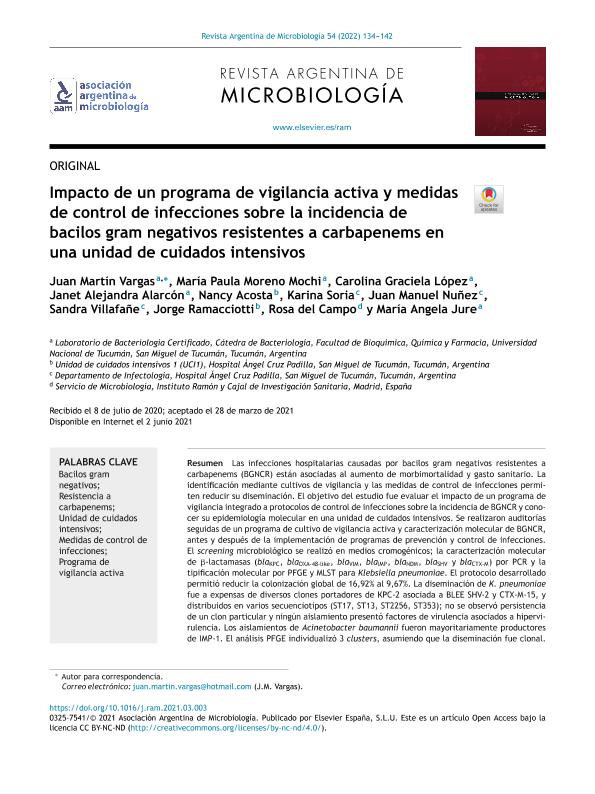Artículo
Impacto de un programa de vigilancia activa y medidas de control de infecciones sobre la incidencia de bacilos gram negativos resistentes a carbapenems en una unidad de cuidados intensivos
Título:
Impact of an active surveillance program and infection control measures on the incidence of carbapenem-resistant gram-negative bacilli in an intensive care unit
Vargas, Juan Martin ; Moreno Mochi, María Paula
; Moreno Mochi, María Paula ; Lopez, Carolina Graciela; Alarcón, Janet Alejandra; Acosta, Nancy; Soria, Karina; Nuñez, Juan Manuel; Villafañe, Sandra; Ramacciotti, Jorge; del Campo, Rosa; Jure, Maria Angela
; Lopez, Carolina Graciela; Alarcón, Janet Alejandra; Acosta, Nancy; Soria, Karina; Nuñez, Juan Manuel; Villafañe, Sandra; Ramacciotti, Jorge; del Campo, Rosa; Jure, Maria Angela
 ; Moreno Mochi, María Paula
; Moreno Mochi, María Paula ; Lopez, Carolina Graciela; Alarcón, Janet Alejandra; Acosta, Nancy; Soria, Karina; Nuñez, Juan Manuel; Villafañe, Sandra; Ramacciotti, Jorge; del Campo, Rosa; Jure, Maria Angela
; Lopez, Carolina Graciela; Alarcón, Janet Alejandra; Acosta, Nancy; Soria, Karina; Nuñez, Juan Manuel; Villafañe, Sandra; Ramacciotti, Jorge; del Campo, Rosa; Jure, Maria Angela
Fecha de publicación:
04/2022
Editorial:
Elsevier
Revista:
Revista Argentina de Microbiología
ISSN:
0325-7541
e-ISSN:
1851-7617
Idioma:
Español
Tipo de recurso:
Artículo publicado
Clasificación temática:
Resumen
Hospital-acquired infections caused by carbapenem-resistant Gram-negative bacteria (CRGNB) have been increasingly reported worldwide and are associated with high rates of mortality especially in intensive care units(ICUs). Early identification through rectal surveillance cultures and implementation of infection control measures(ICM) including contact precautions, staff education on cleaning and hand hygiene may reduce the spread of these microorganisms. The aim of this work was to assess the impact of enhanced ICM on CRGNB colonization and to describe the molecular epidemiology of these bacteria in a polyvalent ICU in a tertiary level hospital. A prospective study including audits and active surveillance culture program, with molecular characterization, was conducted before and after the implementation of prevention programs and infection control measures. Microbiological screening was performed in chromogenic media; PCR targeting β-lactamases genes (blaKPC, blaNDM, blaVIM and blaOXA-48, blaSHV and blaCTX-M), molecular typing by PFGE; and MLST in K. pneumoniae were performed. CRGNB colonization was reduced from 16.92% to 9.67% upon implementing the infection control measures. In K. pneumoniae the most frequent carbapenemase type was KPC-2 associated with SHV-2 and CTX-M-15, and was disseminated in various STs (ST17, ST13, ST2256, ST353); there was no persistence of particular clones and virulence factors showed no association with hypervirulence. IMP-1 carbapenemase predominated in A. baumannii and the PFGE analysis individualized 3 clusters, assuming that the dissemination in the ICU was clonal. The early detection of patients colonized with CRBGN by using epidemiological surveillance cultures and the implementation of prophylactic measures are key to reducing the incidence of these microorganisms.
Archivos asociados
Licencia
Identificadores
Colecciones
Articulos(CCT - NOA SUR)
Articulos de CTRO.CIENTIFICO TECNOL.CONICET - NOA SUR
Articulos de CTRO.CIENTIFICO TECNOL.CONICET - NOA SUR
Citación
Vargas, Juan Martin; Moreno Mochi, María Paula; Lopez, Carolina Graciela; Alarcón, Janet Alejandra; Acosta, Nancy; et al.; Impacto de un programa de vigilancia activa y medidas de control de infecciones sobre la incidencia de bacilos gram negativos resistentes a carbapenems en una unidad de cuidados intensivos; Elsevier; Revista Argentina de Microbiología; 54; 2; 4-2022; 134-142
Compartir
Altmétricas



